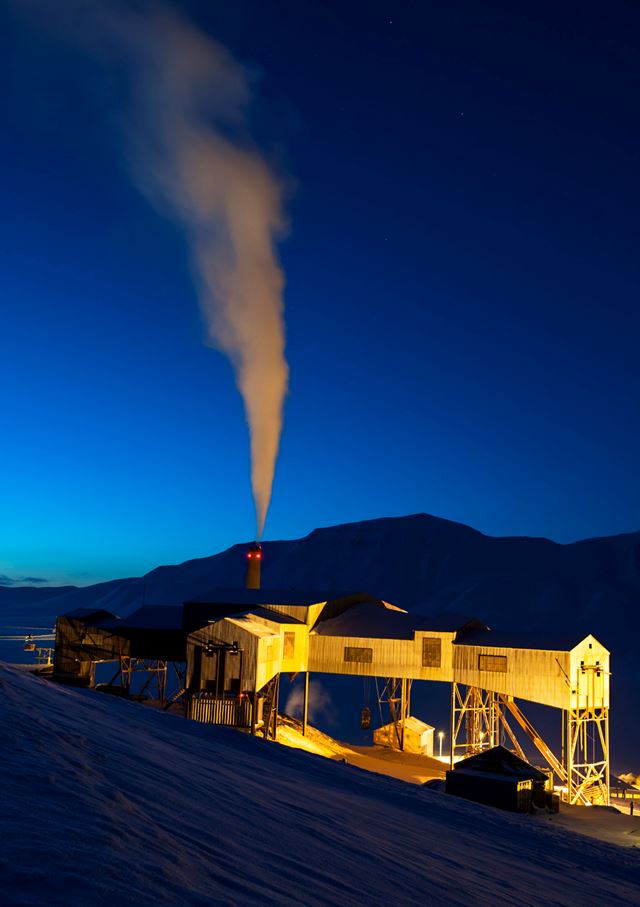
“That Norway, the land of renewables, runs Svalbard on coal, is embarrassing,” declared environmental organisation Bellona recently. At the heart of the matter: Longyearbyen’s coal-fired power station. Photo: Roy Mangersnes / Samfoto
The energy supply to Longyearbyen, midway between continental Norway and the North Pole, is a hot topic in the climate debate.
Longyearbyen is the largest settlement and the administrative centre of Svalbard, a Norwegian archipelago in the Arctic Ocean. Today, Longyearbyen obtains its electric power and district heating from its coal power plant, the only one in Norway.
This plant produces annual emissions of 40 tonnes of CO2 per inhabitant, four times as much as those per mainland inhabitant, even including those generated by the oil industry. This situation has led to reactions from both environmentalists and politicians.
Shipping surplus energy northwards
In the course of the debate about sustainable alternatives, some politicians have already been speaking warmly about replacing Longyearbyen’s coal power plant with a cable between the city and mainland Norway: a 1000-km undersea cable capable of bringing surplus wind- and hydro-power to the country’s outpost in the far north.
A recent study carried out by SINTEF has shown that shipping surplus energy to Svalbard in the form of liquid hydrogen rather than via a cable could mean annual savings of more than NOK 100 million (USD 11.5 million).
The estimated costs include the construction of an electrochemical power station in Longyearbyen. A plant of this type would generate electricity from hydrogen without emissions, by means of fuel cells (see fact-box).
Wide-ranging energy discussion recommended
How hydrogen is produced
- In its Svalbard study, SINTEF assumed that surplus energy from wind and hydropower plants in Norway will be used to split water into hydrogen and oxygen. On the mainland, the amount of surplus power generated annually is around ninety times as great as Longyearbyen’s consumption.
- In its calculations, SINTEF assumed that the hydrogen will be produced in plants on the coast of Norway – for example using wind-power from future wind-farms in Mid-Norway and from an expansion of the Raggovidda wind-farm in Berlevåg in northern Norway, or using hydro-power from Glomfjord, also on northern Norway.
- Green hydrogen production from natural gas is another potential source of supply for Svalbard, according to SINTEF project manager Anders Ødegård, who mentions technology developed by SINTEF, which the Norwegian Reinertsen Group is going to commercialise.
- Natural gas is currently the cheapest and most widely used raw material for hydrogen production. When gas is used as the raw material, CO2 is a by-product. With the SINTEF/Reinertsen solution, however, the CO2 can be separated out and be sent to storage, which would give the natural gas route a completely green energy chain.
Source: SINTEF
For the price of power supplied by a cable to fall to the level of hydrogen-based power, a cable would also have to supply electricity to offshore installations in the Barents Sea, says SINTEF’s project manager Anders Ødegård. Several participants in the debate have made the same point.
“But Svalbard needs a long-term solution. It would not be sensible to depend on oil platforms with a lifetime of only a few decades. Our results make it clear that it is important to discuss Svalbard’s future energy supply on a broad basis and not settle on a cable as the only possible zero-emissions solution,” says Ødegård.
Geothermal energy and green coal power
In one of SINTEF’ scenarios for the future, Svalbard will supply some energy itself by producing solar power during the summer. As winter approaches, more and more electricity will be generated from hydrogen transported from the mainland.
Ødegård emphasises that any further discussion of Svalbard’s future energy situation should also include other alternatives, such as geothermal energy and continued coal-fired electricity generation, with carbon capture and storage.
“The Longyearbyen power station has recently been upgraded to extend its lifetime by 20 years. In a climate perspective, it would be unthinkable to continue with the current level of emissions for such a long time, which is why it is essential to put Svalbard’s energy supply on the agenda now,” says Ødegård.
Fuel from water; of course it is possible
Hydrogen, which is thus a central topic of the new SINTEF study, is a fuel that could be used by both power stations and vehicles. The energy-rich element is not a source of energy as such, but rather an energy carrier.
This is because electrical energy can be stored in the form of hydrogen by passing it through a system that splits water into hydrogen and oxygen.

Anders Ødegård (left) and Jonas Martin have played central roles in drawing up the report. Here, they admire the Svalbard landscape. Photo: private
If the electrical energy used in such hydrogen generation plants is, for example, wind- or hydro-power, the energy chain will be green in its entirety. This is because power plants and vehicles that use hydrogen emit only pure water.
Electricity bills could be cut by more than NOK 100 million a year
If all of Longyearbyen’s electric power were to be generated in a hydrogen power station, it would cost one krone (about € 0.11; USD 0.12) less per kilowatt-hour than power supplied by cable, according to the estimates that the report’s authors regard as most realistic.
“If we combine imported hydrogen and local solar power, Svalbard would save a further NOK 0.20 per kWh,” says Ødegård. At current levels of energy consumption, implementing both solutions would mean that Longyearbyen’s total annual electricity bill would be more than MNOK 100 (USD 11.5 million) lower if hydrogen is used in preference to a cable-based solution.
The door closes on wind-energy
On Norway’s northernmost territory, coal mining has reached its final stages.
“We have assumed that Svalbard will replace mining with new industries of about the same overall dimensions. For that reason, we have based the whole of this study on current levels of consumption,” says Jonas Martin, a German economics student and SINTEF trainee, who has been responsible for performing the calculations under the guidance of SINTEF scientists with long experience in this area.
Wind turbines unlikely to be the solution
- The potential for making Longyearbyen’s energy supply 100 per cent renewable with the aid of local wind turbines was also evaluated by the SINTEF study.
- The research assumed that wind-energy would go to hydrogen production when the wind blows with greater force than electricity consumption can absorb, and that the stored hydrogen can be converted to electricity in fuel cells when it is needed.
- This solution would offer slightly higher prices than a cable from the mainland, but it would also require more wind turbines than would be acceptable on environmental grounds on Svalbard.
- For such a system to be sufficiently reliable without a diesel generator backup system, it would need 100 wind turbines, each with a capacity of 3 MW. These would cover a surface area of 10 km2, and alone would cost more than NOK 4 billion (USD 460 million).
Source: SINTEF
Hydrogen offers flexibility
The MNOK 100 saving is based on a hydrogen price of about NOK 35 (USD 4) per kilo, CIF Longyearbyen.
“We regard this as a realistic price on the basis of consultations with a number of Norwegian suppliers. However, our study shows that hydrogen would be competitive with cable power even at prices up to around NOK 65 (USD 7.5) per kilo,” says Ødegård.
“Major but feasible effort required”
At Fantoft, just outside Bergen, Vegard Frihammer heads the energy company Greenstat, which aims to become a national leader in hydrogen production. Frihammer’s company has analysed that hydrogen produced at the Mongstad oil refinery on the west coast of Norway would cost about NOK 22 (USD 2.50) per kilo.
“Like SINTEF, we are working on a number of studies regarding the liquefaction and transport of hydrogen. But in these areas, there are no public figures we can refer to yet,” says Frihammer.
What he does know, however, is what Norwegian suppliers of hydrogen will need to be prepared for in order to be price-competitive.
“We have had good indications from Japan that companies that want to supply the country with hydrogen will need to price their product between about NOK 20 (USD 2.30) and NOK 45 (USD 5.20) per kg at the quay (CIF). Our aim is that in 2030, green hydrogen from Norway should cost NOK 30 (USD 3.45) per kg, CIF Japan. This will involve a major effort throughout the value chain, but it ought to be within reach. And if we can reach this goal for supplying Japan, NOK 30 should be a realistic price on Svalbard too.”
How hydrogen can be used
- Hydrogen is one of several alternative means of storing electricity generated by unpredictable gusts of wind and solar radiation until it is needed.
- Hydrogen can be cooled until it liquefies and can be transported in special tankers. The first vessel of this type is currently being built to carry liquid hydrogen to Japan, and it will be ready in time for the Tokyo Olympics in 2020.
- Fuel cells, modular electrochemical power stations, convert hydrogen and oxygen (the latter from the atmosphere) to electricity, water and heat. A hydrogen power station on Svalbard would consist of a large number of such modules.
- On Svalbard, the heat generated by fuel cells would be utilised for district heating all year round, thus offering a highly efficient energy cycle. Fuel cell modules are already being supplied in containers. This solution can therefore be scaled up (and down) in order to adapt to changes in energy requirements.
- The first hydrogen-fuelled snow-scooter has already been demonstrated, and hydrogen cars are being mass-produced by Hyundai, Toyota and Honda. Hydrogen technology could thus also make personal transport on Svalbard completely emission-free.
Source: SINTEF


